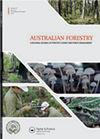Estimated herbicide use in the commercial forest sector in South Africa
IF 1.2
4区 农林科学
Q3 FORESTRY
引用次数: 4
Abstract
ABSTRACT This paper examines herbicide use in South African commercial plantations in 2017/18 across three climate zones (cool temperate − CT, warm temperate − WT and subtropical − ST) for three genera (eucalypts, pines and acacias) grown for two end-products (sawn timber and pulpwood). Herbicide information was obtained from 46 timber plantations owned by six forestry companies, comprising 343 872 ha surveyed. The herbicide survey was divided into three climate zones due to increased vegetation growth (and hence more herbicide use) on more productive ST sites compared to moderately productive WT sites, with the lowest vegetation growth on CT sites (lower productivity). The survey was further divided into three distinct vegetation management phases associated with plantation forestry (pre-establishment, re-establishment and post-establishment) to compare herbicide use bet ween genera grown on an annual basis. A total of 188 288 kg (or 0.55 kg ha−1) of herbicide active ingredient (a.i.) was applied in the area surveyed. Glyphosate-based products accounted for 97% of all the herbicides applied, and metazachlor and triclopyr butoxy ethyl ester accounted for 2%. Overall, herbicide use per hectare on an annual basis was highest in the ST zone, followed by the WT and CT zones. For both the CT and WT zones, the general trend was that the pre-establishment phase received noticeably more herbicides, followed by the re- and post-establishment phases (pre re post). This trend remained similar for the genera grown (pre re post), with hardwoods receiving more herbicides than softwoods. In contrast, there was little difference in herbicide use between the re- and pre-establishment phases for the ST zone, with the post-establishment phase being noticeably less. Besides providing benchmark data related to herbicide use in South African plantations, future research should investigate the potential for a reduction in herbicide use in those regions, vegetation management phases and management regimes where it is highest.估计南非商业森林部门的除草剂使用情况
本文研究了2017/18年南非商业种植园中三个气候带(冷温带- CT,暖温带- WT和亚热带- ST)的除草剂使用情况,涉及三个属(桉树,松树和金合欢)的两种最终产品(锯材和纸浆木)。从6家林业公司拥有的46个木材种植园获得了除草剂信息,共调查了343 872公顷。除草剂调查被划分为三个气候带,因为与中等生产力的WT站点相比,高生产力的ST站点的植被生长增加(因此使用更多的除草剂),而高生产力站点的植被生长最低(生产力较低)。调查进一步分为与人工林有关的三个不同的植被管理阶段(建立前、重建和建立后),以比较每年种植的属之间的除草剂使用情况。调查地区共施用了188 288 kg (0.55 kg ha - 1)除草剂有效成分(a.i)。草甘膦类除草剂占全部除草剂用量的97%,甲虫胺和三氯丁氧乙酯占2%。总体而言,每年每公顷除草剂使用量在ST区最高,其次是WT区和CT区。对于CT区和WT区,总体趋势是建立前阶段使用的除草剂明显更多,其次是建立后和重建阶段(pre - re- post)。这一趋势在已生长(前后)的属中保持相似,硬木比软木使用更多的除草剂。相比之下,ST区除草剂的重新建立阶段和建立前阶段的除草剂使用差异不大,建立后阶段的除草剂使用明显减少。除了提供与南非种植园除草剂使用有关的基准数据外,未来的研究还应调查在这些区域减少除草剂使用的可能性、减少除草剂使用最多的植被管理阶段和管理制度。
本文章由计算机程序翻译,如有差异,请以英文原文为准。
求助全文
约1分钟内获得全文
求助全文
来源期刊

Australian Forestry
FORESTRY-
CiteScore
3.70
自引率
4.80%
发文量
15
审稿时长
>12 weeks
期刊介绍:
Australian Forestry is published by Taylor & Francis for the Institute of Foresters of Australia (IFA) for scientific, technical, and professional communication relating to forestry in the Asia Pacific.
 求助内容:
求助内容: 应助结果提醒方式:
应助结果提醒方式:


